Bachelor of Business/Accounting FINM202: Financial Information Report
VerifiedAdded on 2023/06/07
|13
|2421
|299
Report
AI Summary
This report presents a comprehensive financial analysis of ABC Retail Company, covering various aspects of financial management. It begins by calculating the share price and market capitalization using the price-earnings ratio and earnings per share, followed by a comparison of ABC's P/E ratio with industry averages to assess potential undervaluation. The report then delves into ratio analysis, calculating and interpreting current, quick, and working capital ratios over a three-year period. It assesses working capital efficiency through inventory turnover and collection ratios, highlighting the company's performance in managing its current assets and liabilities. Profitability trends are examined using operating profit, net profit, and EPS ratios, revealing a declining trend in the company's profitability. The report also identifies the debt-equity ratio as a key solvency metric, recommending that a bank should assess this ratio before lending to the company. Furthermore, the report includes a business report analyzing the role of ethics in corporate governance, using the AMP financial services company as a real-world example. It discusses the importance of ethical policies, agency and stakeholder theories, and the impact of unethical practices on corporate governance, concluding with the need to integrate ethics and social responsibility in corporate frameworks to protect stakeholder interests.
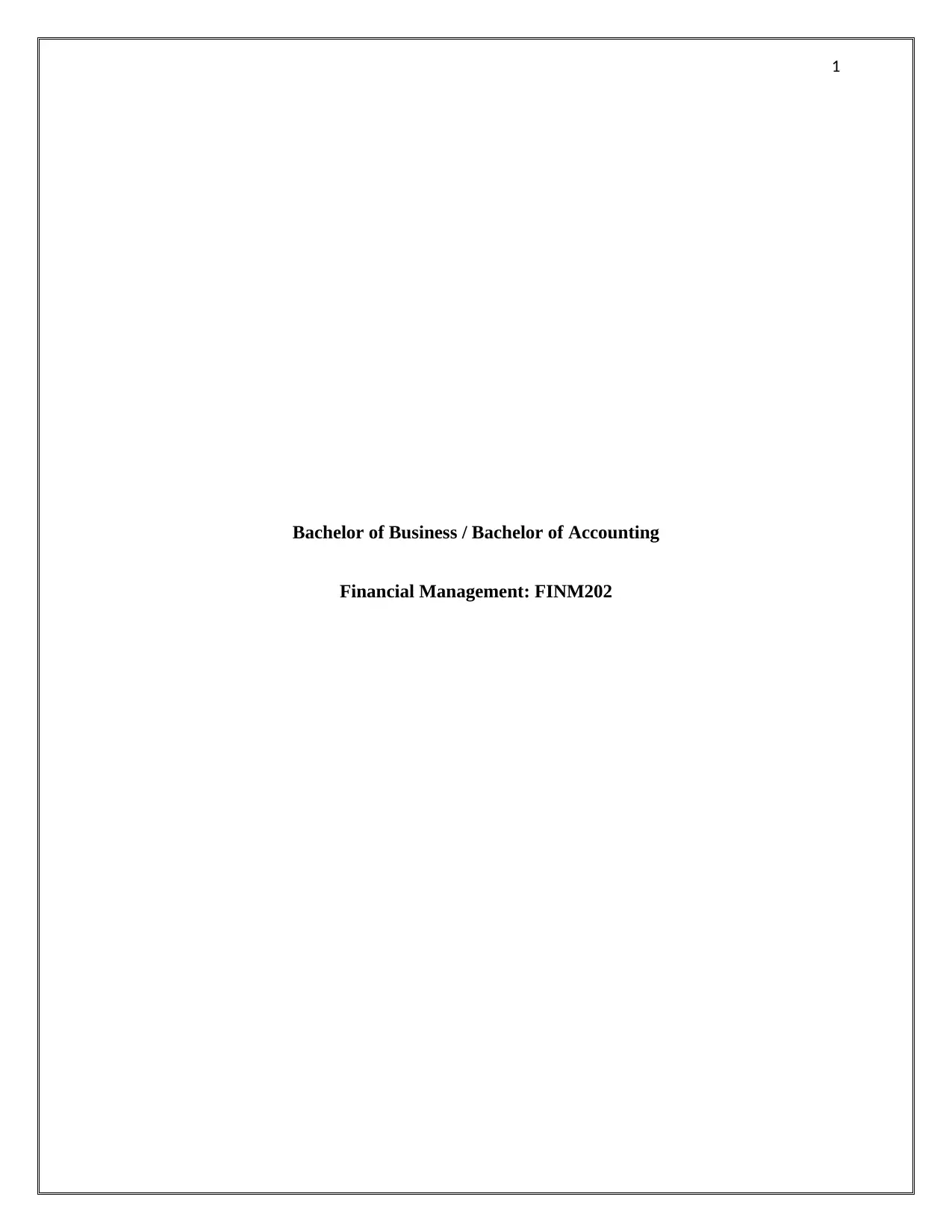
1
Bachelor of Business / Bachelor of Accounting
Financial Management: FINM202
Bachelor of Business / Bachelor of Accounting
Financial Management: FINM202
Paraphrase This Document
Need a fresh take? Get an instant paraphrase of this document with our AI Paraphraser
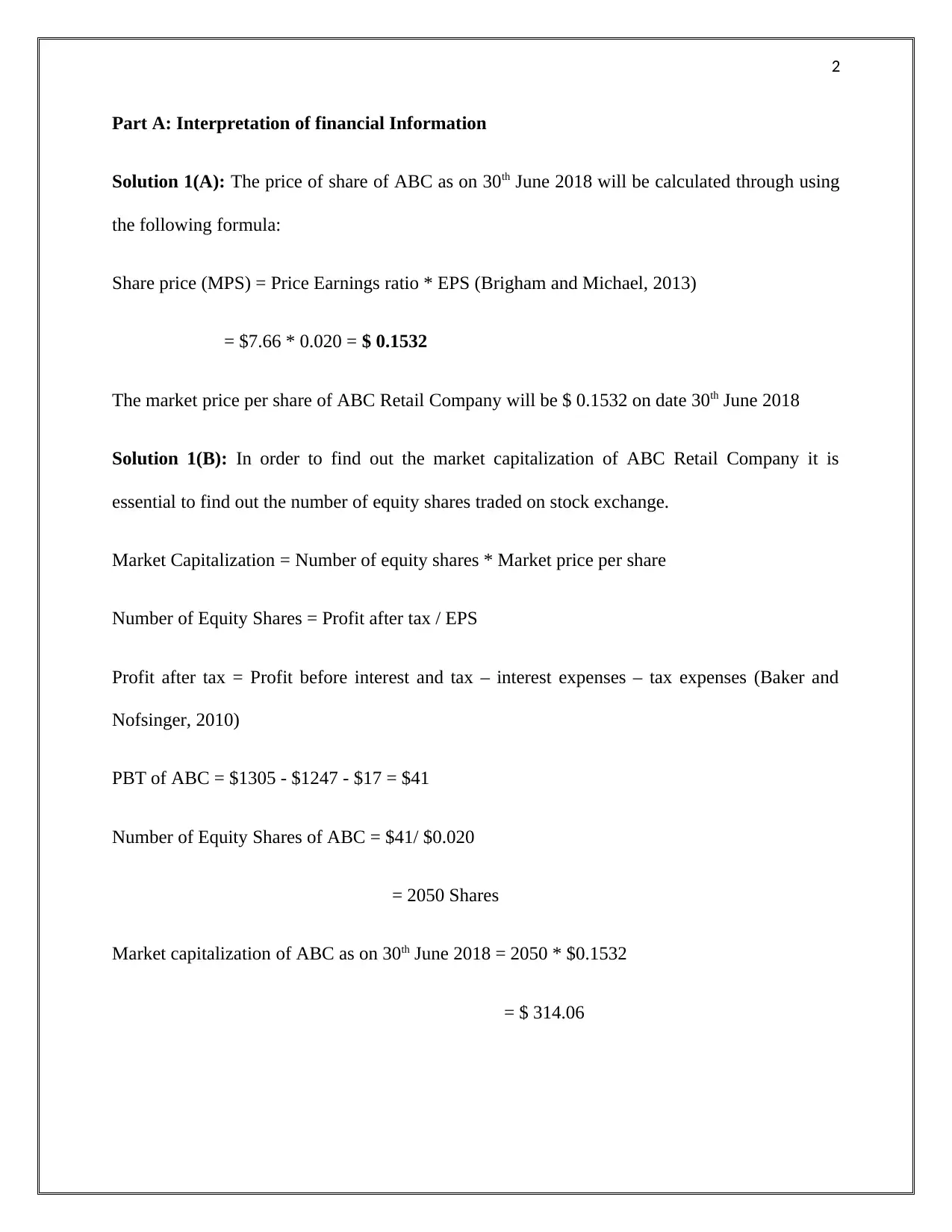
2
Part A: Interpretation of financial Information
Solution 1(A): The price of share of ABC as on 30th June 2018 will be calculated through using
the following formula:
Share price (MPS) = Price Earnings ratio * EPS (Brigham and Michael, 2013)
= $7.66 * 0.020 = $ 0.1532
The market price per share of ABC Retail Company will be $ 0.1532 on date 30th June 2018
Solution 1(B): In order to find out the market capitalization of ABC Retail Company it is
essential to find out the number of equity shares traded on stock exchange.
Market Capitalization = Number of equity shares * Market price per share
Number of Equity Shares = Profit after tax / EPS
Profit after tax = Profit before interest and tax – interest expenses – tax expenses (Baker and
Nofsinger, 2010)
PBT of ABC = $1305 - $1247 - $17 = $41
Number of Equity Shares of ABC = $41/ $0.020
= 2050 Shares
Market capitalization of ABC as on 30th June 2018 = 2050 * $0.1532
= $ 314.06
Part A: Interpretation of financial Information
Solution 1(A): The price of share of ABC as on 30th June 2018 will be calculated through using
the following formula:
Share price (MPS) = Price Earnings ratio * EPS (Brigham and Michael, 2013)
= $7.66 * 0.020 = $ 0.1532
The market price per share of ABC Retail Company will be $ 0.1532 on date 30th June 2018
Solution 1(B): In order to find out the market capitalization of ABC Retail Company it is
essential to find out the number of equity shares traded on stock exchange.
Market Capitalization = Number of equity shares * Market price per share
Number of Equity Shares = Profit after tax / EPS
Profit after tax = Profit before interest and tax – interest expenses – tax expenses (Baker and
Nofsinger, 2010)
PBT of ABC = $1305 - $1247 - $17 = $41
Number of Equity Shares of ABC = $41/ $0.020
= 2050 Shares
Market capitalization of ABC as on 30th June 2018 = 2050 * $0.1532
= $ 314.06

3
Solution 1(C): In order to ABC’s recent P/E ratio with the industry average there is need to find
out P/E ratio of retail industry of Australia for year 2018. To compute the industry average of
P/E ratio for retail industry of Australia it has been decided to take average of two retail
companies in Australia. The two companies selected for this purpose are Wesfarmers and
Woolworth. Both the selected companies belong of retail industry of Australia.
P/E Ratio of Wesfarmers= 48.66 Times (Yahoo Finance: Wesfarmers, 2018)
P/E Ratio of Woolworth= 21.40 Times (Yahoo Finance: Woolworth, 2018)
P/E Ratio Industry Average (Most recent) = (48.66+21.40)/2 = 35.03 Times
P/E Ratio of ABC Retail Company = 7.66 Times
As per information on P/E Ratio of ABC Company and industry average it can be
evaluated that share price value of ABC may be undervalued but there is still good margin for
growth in the market value of the company.
Solution 2:
The formula to calculate the current ratio and quick ratio is given below:
Current ratio: Current assets/Current Liabilities
Quick ratio: Quick Assets/Current Liabilities (Brigham and Michael, 2013)
To compute the quick assets there is need to subtract value of inventory from the current assets.
Particulars 2016 2017 2018
Current Assets 11171 12432 13533
Current Liabilities 6238 4167 4047
Solution 1(C): In order to ABC’s recent P/E ratio with the industry average there is need to find
out P/E ratio of retail industry of Australia for year 2018. To compute the industry average of
P/E ratio for retail industry of Australia it has been decided to take average of two retail
companies in Australia. The two companies selected for this purpose are Wesfarmers and
Woolworth. Both the selected companies belong of retail industry of Australia.
P/E Ratio of Wesfarmers= 48.66 Times (Yahoo Finance: Wesfarmers, 2018)
P/E Ratio of Woolworth= 21.40 Times (Yahoo Finance: Woolworth, 2018)
P/E Ratio Industry Average (Most recent) = (48.66+21.40)/2 = 35.03 Times
P/E Ratio of ABC Retail Company = 7.66 Times
As per information on P/E Ratio of ABC Company and industry average it can be
evaluated that share price value of ABC may be undervalued but there is still good margin for
growth in the market value of the company.
Solution 2:
The formula to calculate the current ratio and quick ratio is given below:
Current ratio: Current assets/Current Liabilities
Quick ratio: Quick Assets/Current Liabilities (Brigham and Michael, 2013)
To compute the quick assets there is need to subtract value of inventory from the current assets.
Particulars 2016 2017 2018
Current Assets 11171 12432 13533
Current Liabilities 6238 4167 4047
⊘ This is a preview!⊘
Do you want full access?
Subscribe today to unlock all pages.

Trusted by 1+ million students worldwide
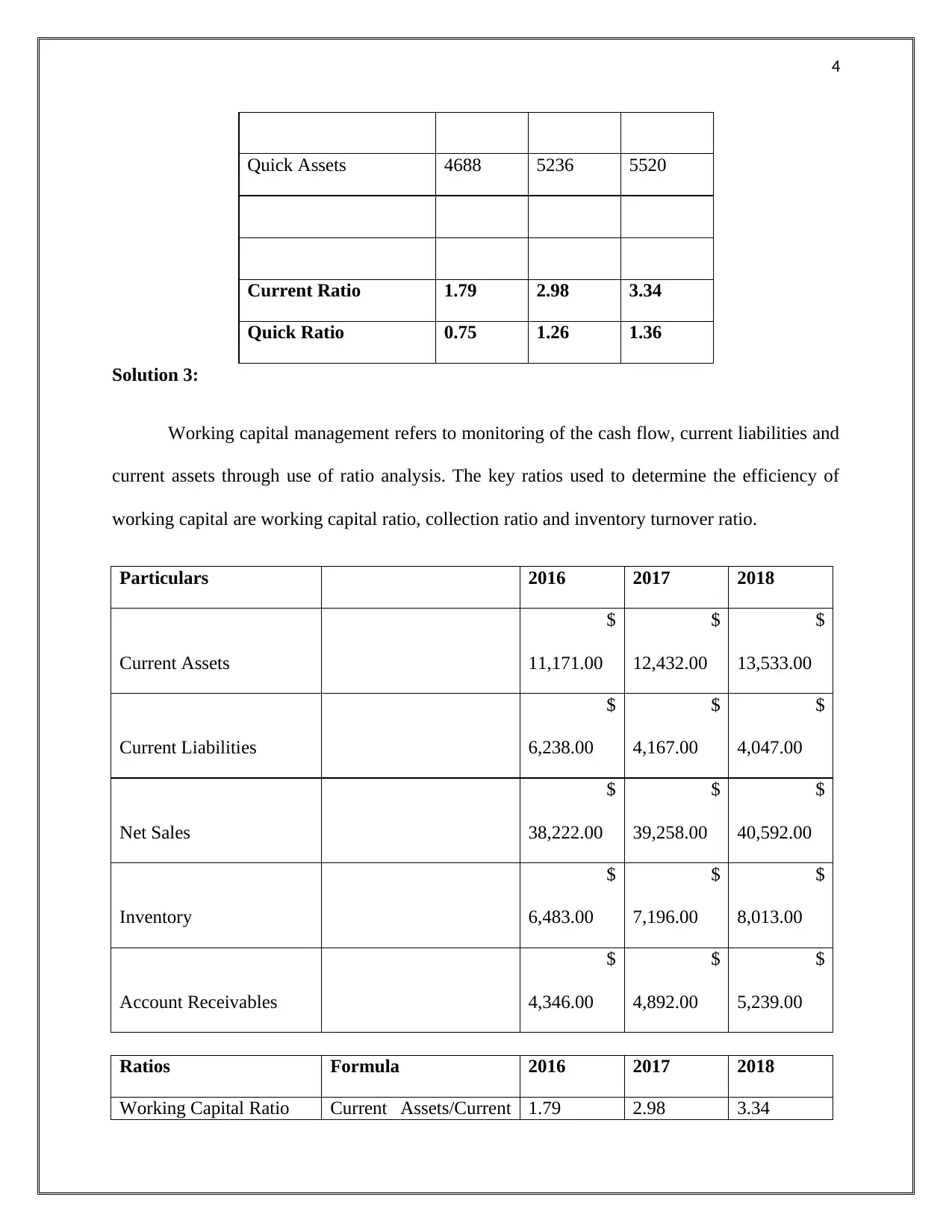
4
Quick Assets 4688 5236 5520
Current Ratio 1.79 2.98 3.34
Quick Ratio 0.75 1.26 1.36
Solution 3:
Working capital management refers to monitoring of the cash flow, current liabilities and
current assets through use of ratio analysis. The key ratios used to determine the efficiency of
working capital are working capital ratio, collection ratio and inventory turnover ratio.
Particulars 2016 2017 2018
Current Assets
$
11,171.00
$
12,432.00
$
13,533.00
Current Liabilities
$
6,238.00
$
4,167.00
$
4,047.00
Net Sales
$
38,222.00
$
39,258.00
$
40,592.00
Inventory
$
6,483.00
$
7,196.00
$
8,013.00
Account Receivables
$
4,346.00
$
4,892.00
$
5,239.00
Ratios Formula 2016 2017 2018
Working Capital Ratio Current Assets/Current 1.79 2.98 3.34
Quick Assets 4688 5236 5520
Current Ratio 1.79 2.98 3.34
Quick Ratio 0.75 1.26 1.36
Solution 3:
Working capital management refers to monitoring of the cash flow, current liabilities and
current assets through use of ratio analysis. The key ratios used to determine the efficiency of
working capital are working capital ratio, collection ratio and inventory turnover ratio.
Particulars 2016 2017 2018
Current Assets
$
11,171.00
$
12,432.00
$
13,533.00
Current Liabilities
$
6,238.00
$
4,167.00
$
4,047.00
Net Sales
$
38,222.00
$
39,258.00
$
40,592.00
Inventory
$
6,483.00
$
7,196.00
$
8,013.00
Account Receivables
$
4,346.00
$
4,892.00
$
5,239.00
Ratios Formula 2016 2017 2018
Working Capital Ratio Current Assets/Current 1.79 2.98 3.34
Paraphrase This Document
Need a fresh take? Get an instant paraphrase of this document with our AI Paraphraser

5
Liabilities
Inventory Turnover Ratio Net Sales /Inventory 5.90 5.46 5.07
Collection Ratio
(Accounts
Receivables/Sales)*365 41.50 45.48 47.11
(Baker and Nofsinger, 2010)
As the collection ratio shows an increasing trend that indicates the efficiency of
management has been decreasing year by year in collecting the accounts receivables from their
customers. Inventory turnover ratio has decreased from year 5.90 times to 5.07 times in three
year span that clearly indicates that ABC has made more purchases as required to be made.
Working capital ratio was between 1.79 times to 3.34 times that shows ABC has enough current
assets to pay the current liabilities. So overall working capital position of ABC Company was
satisfactory and it is recommended to managers to improve the collection policies so that
collection ratio can be improved.
Solution 4:
Trends in the profitability position of the ABC Retail Company
Particulars 2016 2017 2018
Operating Income
(EBIT)
$
1,208.00
$
1,281.00
$
1,305.00
Net Profit (EAT)
$
92.00
$
46.00
$
41.00
Net Sales
$
38,222.00
$
39,258.00
$
40,592.00
Liabilities
Inventory Turnover Ratio Net Sales /Inventory 5.90 5.46 5.07
Collection Ratio
(Accounts
Receivables/Sales)*365 41.50 45.48 47.11
(Baker and Nofsinger, 2010)
As the collection ratio shows an increasing trend that indicates the efficiency of
management has been decreasing year by year in collecting the accounts receivables from their
customers. Inventory turnover ratio has decreased from year 5.90 times to 5.07 times in three
year span that clearly indicates that ABC has made more purchases as required to be made.
Working capital ratio was between 1.79 times to 3.34 times that shows ABC has enough current
assets to pay the current liabilities. So overall working capital position of ABC Company was
satisfactory and it is recommended to managers to improve the collection policies so that
collection ratio can be improved.
Solution 4:
Trends in the profitability position of the ABC Retail Company
Particulars 2016 2017 2018
Operating Income
(EBIT)
$
1,208.00
$
1,281.00
$
1,305.00
Net Profit (EAT)
$
92.00
$
46.00
$
41.00
Net Sales
$
38,222.00
$
39,258.00
$
40,592.00
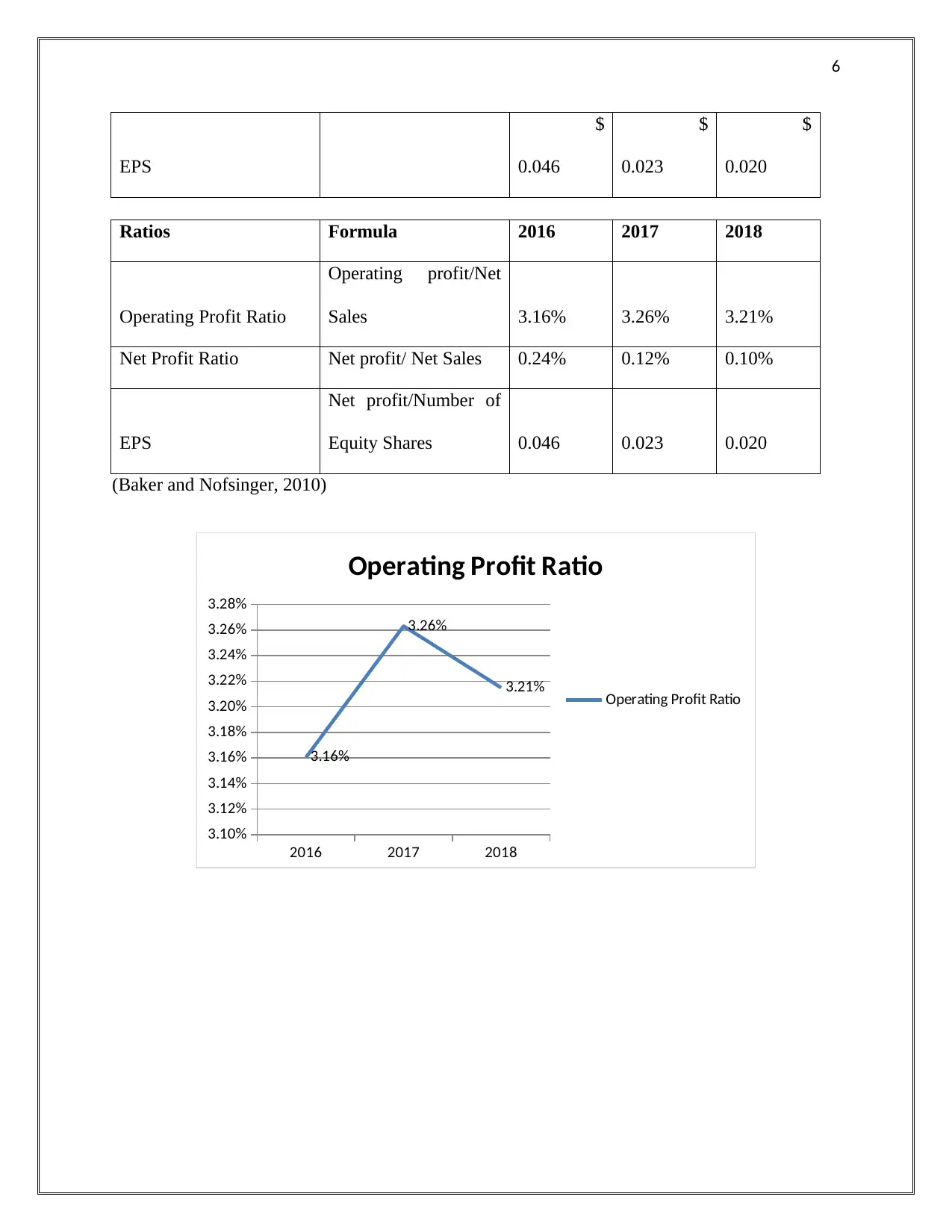
6
EPS
$
0.046
$
0.023
$
0.020
Ratios Formula 2016 2017 2018
Operating Profit Ratio
Operating profit/Net
Sales 3.16% 3.26% 3.21%
Net Profit Ratio Net profit/ Net Sales 0.24% 0.12% 0.10%
EPS
Net profit/Number of
Equity Shares 0.046 0.023 0.020
(Baker and Nofsinger, 2010)
2016 2017 2018
3.10%
3.12%
3.14%
3.16%
3.18%
3.20%
3.22%
3.24%
3.26%
3.28%
3.16%
3.26%
3.21%
Operating Profit Ratio
Operating Profit Ratio
EPS
$
0.046
$
0.023
$
0.020
Ratios Formula 2016 2017 2018
Operating Profit Ratio
Operating profit/Net
Sales 3.16% 3.26% 3.21%
Net Profit Ratio Net profit/ Net Sales 0.24% 0.12% 0.10%
EPS
Net profit/Number of
Equity Shares 0.046 0.023 0.020
(Baker and Nofsinger, 2010)
2016 2017 2018
3.10%
3.12%
3.14%
3.16%
3.18%
3.20%
3.22%
3.24%
3.26%
3.28%
3.16%
3.26%
3.21%
Operating Profit Ratio
Operating Profit Ratio
⊘ This is a preview!⊘
Do you want full access?
Subscribe today to unlock all pages.

Trusted by 1+ million students worldwide

7
2016 2017 2018
0.00%
0.05%
0.10%
0.15%
0.20%
0.25%
0.30%
0.24%
0.12% 0.10%
Net Profit Ratio
Net Profit Ratio
2016 2017 2018
0.000
0.005
0.010
0.015
0.020
0.025
0.030
0.035
0.040
0.045
0.050
0.046
0.023 0.020
EPS
EPS
Analysis of profitability position of ABC during the last three years
On the basis of trend analysis of profitability performance of ABC during the last three
years it can be said that there has been decreasing trend in net profit ratio and also in EPS. The
decreasing trend indicates poor profitability performance of ABC Company.
Solution 5:
2016 2017 2018
0.00%
0.05%
0.10%
0.15%
0.20%
0.25%
0.30%
0.24%
0.12% 0.10%
Net Profit Ratio
Net Profit Ratio
2016 2017 2018
0.000
0.005
0.010
0.015
0.020
0.025
0.030
0.035
0.040
0.045
0.050
0.046
0.023 0.020
EPS
EPS
Analysis of profitability position of ABC during the last three years
On the basis of trend analysis of profitability performance of ABC during the last three
years it can be said that there has been decreasing trend in net profit ratio and also in EPS. The
decreasing trend indicates poor profitability performance of ABC Company.
Solution 5:
Paraphrase This Document
Need a fresh take? Get an instant paraphrase of this document with our AI Paraphraser

8
The best solvency ratio that will help bank to evaluate the solvency position of the ABC
Company is Debt Equity Ratio. The debt equity compares the total debt to total equity capital of
the company. Higher debt equity ratio Shows Company has used more debt capital (Bank Loan)
to finance the assets of the company as compare to the equity capital (Brigham and Michael,
2013).
Formula of Debt Equity Capital: Debt /Equity
= $10750/$4998 = 2.150
The debt equity ratio of 2.150 indicates that ABC Company has used 2.150 times the debt
capital as compare to equity capital. Looking at the debt equity ratio of ABC Company, bank
should lend the fund to the company as it will increase the debt equity ratio which can affect the
liquidity and profitability performance of the company.
Part B: Business Report
Introduction
The present report is developed for providing an understanding of the role of ethics in
corporate governance. This has been carried out by demonstrating an application of the real-
world example from an Australian financial corporation. The selected financial corporation is
AMP, a financial services company based in Australia and New Zealand involved in providing
superannuation and investment products. The report has carried out an analysis of the recent
news regarding AMP and its relation with corporate regulator.
Analysis of Recent News Regarding AMP for Depicting the Role of Ethics in Corporate
Governance
The best solvency ratio that will help bank to evaluate the solvency position of the ABC
Company is Debt Equity Ratio. The debt equity compares the total debt to total equity capital of
the company. Higher debt equity ratio Shows Company has used more debt capital (Bank Loan)
to finance the assets of the company as compare to the equity capital (Brigham and Michael,
2013).
Formula of Debt Equity Capital: Debt /Equity
= $10750/$4998 = 2.150
The debt equity ratio of 2.150 indicates that ABC Company has used 2.150 times the debt
capital as compare to equity capital. Looking at the debt equity ratio of ABC Company, bank
should lend the fund to the company as it will increase the debt equity ratio which can affect the
liquidity and profitability performance of the company.
Part B: Business Report
Introduction
The present report is developed for providing an understanding of the role of ethics in
corporate governance. This has been carried out by demonstrating an application of the real-
world example from an Australian financial corporation. The selected financial corporation is
AMP, a financial services company based in Australia and New Zealand involved in providing
superannuation and investment products. The report has carried out an analysis of the recent
news regarding AMP and its relation with corporate regulator.
Analysis of Recent News Regarding AMP for Depicting the Role of Ethics in Corporate
Governance

9
Corporate governance can be defined as the framework of rules, practices and processes
by which a firm is directed and controlled. The establishment of relevant rules and regulations is
necessary for promoting transparency, accountability and honesty in business operations as it
provides a framework to both employer and employees to carry out their job responsibilities. The
role of ethics in development of corporate governance polices is very essential for protecting the
interests of the stakeholders by enhancing integrity and responsibility in business practices. The
business organizations are required to implement ethical policies and practices at the time of
developing the corporate governance policies. This is because the absence of relevant ethical
standards within the workplace can lead to bad corporate governance framework that can lead to
the occurrence of unethical issues (Bergstein, 2014).
The importance of adopting ethical corporate governance policies by a business
corporation can be explained by demonstrating the example of a financial corporation of
Australia, that is, AMP. AMP is known to be a financial services company of Australia that is
mainly involved in providing of superannuation and investment products, insurance, financial
advices and other types of banking products. The financial services sector of Australia is under
scrutiny after the banking Royal Commission has reported various scandals relating to culture
and governance issues. AMP has admitted to the financial services royal commission over use of
unethical practices for deceiving the corporate regulator ASIC (Australian Securities Investment
Corporation). The company has admitted that it has deceived large number of customers by
charging them the fees for its financial services but has not provided the required services in
exchange of the fees charged. It has been claimed that about 30,000 customers have not received
an annual financial check-up for which they have provided the fees. It has been admitted by the
Corporate governance can be defined as the framework of rules, practices and processes
by which a firm is directed and controlled. The establishment of relevant rules and regulations is
necessary for promoting transparency, accountability and honesty in business operations as it
provides a framework to both employer and employees to carry out their job responsibilities. The
role of ethics in development of corporate governance polices is very essential for protecting the
interests of the stakeholders by enhancing integrity and responsibility in business practices. The
business organizations are required to implement ethical policies and practices at the time of
developing the corporate governance policies. This is because the absence of relevant ethical
standards within the workplace can lead to bad corporate governance framework that can lead to
the occurrence of unethical issues (Bergstein, 2014).
The importance of adopting ethical corporate governance policies by a business
corporation can be explained by demonstrating the example of a financial corporation of
Australia, that is, AMP. AMP is known to be a financial services company of Australia that is
mainly involved in providing of superannuation and investment products, insurance, financial
advices and other types of banking products. The financial services sector of Australia is under
scrutiny after the banking Royal Commission has reported various scandals relating to culture
and governance issues. AMP has admitted to the financial services royal commission over use of
unethical practices for deceiving the corporate regulator ASIC (Australian Securities Investment
Corporation). The company has admitted that it has deceived large number of customers by
charging them the fees for its financial services but has not provided the required services in
exchange of the fees charged. It has been claimed that about 30,000 customers have not received
an annual financial check-up for which they have provided the fees. It has been admitted by the
⊘ This is a preview!⊘
Do you want full access?
Subscribe today to unlock all pages.

Trusted by 1+ million students worldwide
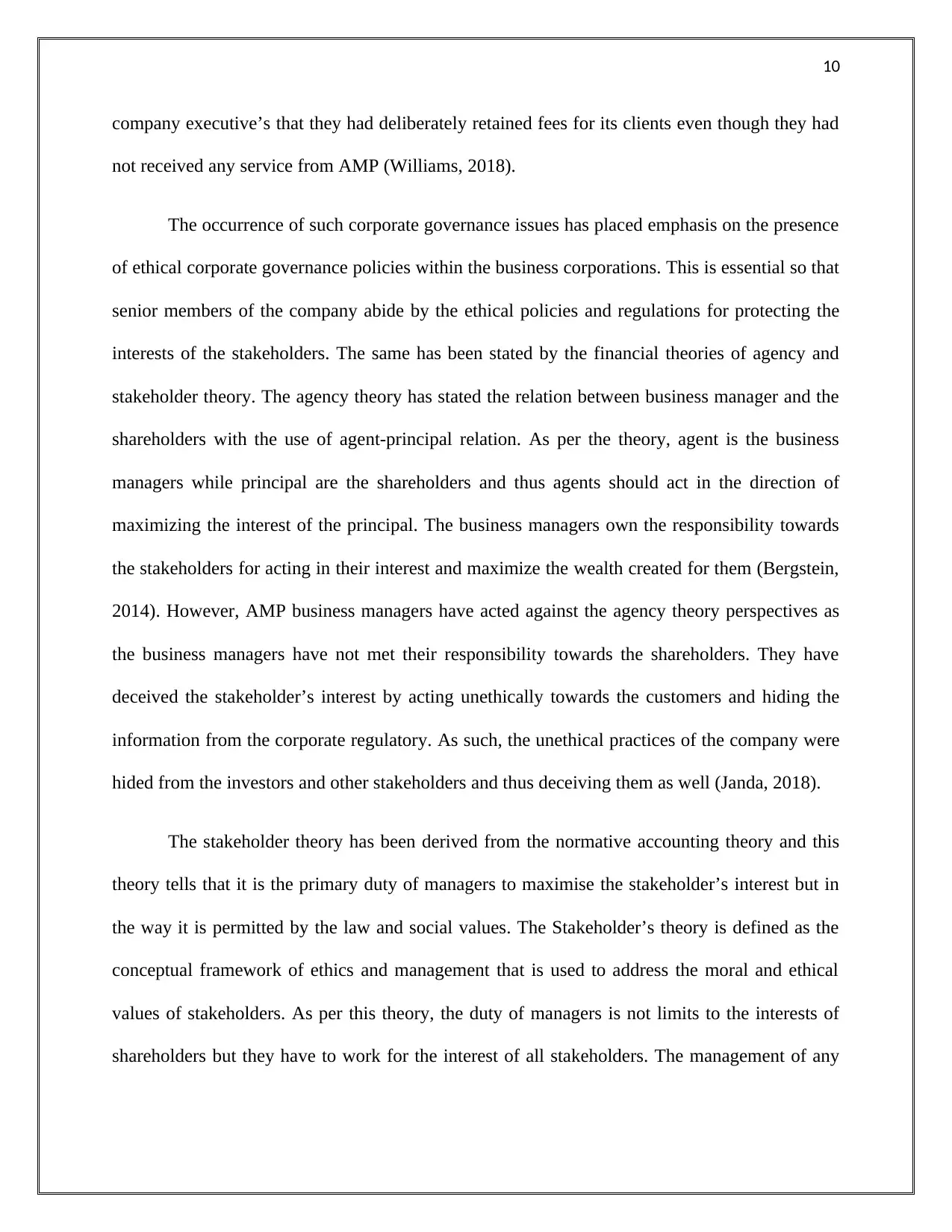
10
company executive’s that they had deliberately retained fees for its clients even though they had
not received any service from AMP (Williams, 2018).
The occurrence of such corporate governance issues has placed emphasis on the presence
of ethical corporate governance policies within the business corporations. This is essential so that
senior members of the company abide by the ethical policies and regulations for protecting the
interests of the stakeholders. The same has been stated by the financial theories of agency and
stakeholder theory. The agency theory has stated the relation between business manager and the
shareholders with the use of agent-principal relation. As per the theory, agent is the business
managers while principal are the shareholders and thus agents should act in the direction of
maximizing the interest of the principal. The business managers own the responsibility towards
the stakeholders for acting in their interest and maximize the wealth created for them (Bergstein,
2014). However, AMP business managers have acted against the agency theory perspectives as
the business managers have not met their responsibility towards the shareholders. They have
deceived the stakeholder’s interest by acting unethically towards the customers and hiding the
information from the corporate regulatory. As such, the unethical practices of the company were
hided from the investors and other stakeholders and thus deceiving them as well (Janda, 2018).
The stakeholder theory has been derived from the normative accounting theory and this
theory tells that it is the primary duty of managers to maximise the stakeholder’s interest but in
the way it is permitted by the law and social values. The Stakeholder’s theory is defined as the
conceptual framework of ethics and management that is used to address the moral and ethical
values of stakeholders. As per this theory, the duty of managers is not limits to the interests of
shareholders but they have to work for the interest of all stakeholders. The management of any
company executive’s that they had deliberately retained fees for its clients even though they had
not received any service from AMP (Williams, 2018).
The occurrence of such corporate governance issues has placed emphasis on the presence
of ethical corporate governance policies within the business corporations. This is essential so that
senior members of the company abide by the ethical policies and regulations for protecting the
interests of the stakeholders. The same has been stated by the financial theories of agency and
stakeholder theory. The agency theory has stated the relation between business manager and the
shareholders with the use of agent-principal relation. As per the theory, agent is the business
managers while principal are the shareholders and thus agents should act in the direction of
maximizing the interest of the principal. The business managers own the responsibility towards
the stakeholders for acting in their interest and maximize the wealth created for them (Bergstein,
2014). However, AMP business managers have acted against the agency theory perspectives as
the business managers have not met their responsibility towards the shareholders. They have
deceived the stakeholder’s interest by acting unethically towards the customers and hiding the
information from the corporate regulatory. As such, the unethical practices of the company were
hided from the investors and other stakeholders and thus deceiving them as well (Janda, 2018).
The stakeholder theory has been derived from the normative accounting theory and this
theory tells that it is the primary duty of managers to maximise the stakeholder’s interest but in
the way it is permitted by the law and social values. The Stakeholder’s theory is defined as the
conceptual framework of ethics and management that is used to address the moral and ethical
values of stakeholders. As per this theory, the duty of managers is not limits to the interests of
shareholders but they have to work for the interest of all stakeholders. The management of any
Paraphrase This Document
Need a fresh take? Get an instant paraphrase of this document with our AI Paraphraser

11
business organization is completely responsible to provide all the material information to the
stakeholders so that they can be aware of the actual performance of the company.
It has been found in AMC case that management has deliberately over charged fees from
their clients and has not provided the services for which fees has been charged for. It clearly
signifies that management at AMC has violated the stakeholder theory as managers of AMC
have played with the interest of their clients which is very serious concern on the part of
company accountability. The stakeholder theory clearly mentions that managers must inform the
stakeholders about any major change in the policies of the company but managers at AMC have
failed to perform their duty.
The scandalous behavior of the AMP has caused the ASX Corporate Governance council
to re-draft some of core principles of corporate governance for improving the corporate culture.
The recommended changes are directed for resolving the governance issues recently reported in
the financial service sector of Australia by royal commission. The recommended change has
urged the companies to adopt and continually reinforce a culture of acting lawfully, ethically and
in a socially responsible manner (ASX proposes tougher governance guidelines, 2018).
Conclusion
Thus, it can be stated from the real-world example of the financial service company of
AMP who has breached the corporate governance framework of ASX that it is required to
integrate the principle of ethics and social responsibility in such a framework. This is essential to
protect the interest of the stakeholders and promoting transparency in the business corporations.
business organization is completely responsible to provide all the material information to the
stakeholders so that they can be aware of the actual performance of the company.
It has been found in AMC case that management has deliberately over charged fees from
their clients and has not provided the services for which fees has been charged for. It clearly
signifies that management at AMC has violated the stakeholder theory as managers of AMC
have played with the interest of their clients which is very serious concern on the part of
company accountability. The stakeholder theory clearly mentions that managers must inform the
stakeholders about any major change in the policies of the company but managers at AMC have
failed to perform their duty.
The scandalous behavior of the AMP has caused the ASX Corporate Governance council
to re-draft some of core principles of corporate governance for improving the corporate culture.
The recommended changes are directed for resolving the governance issues recently reported in
the financial service sector of Australia by royal commission. The recommended change has
urged the companies to adopt and continually reinforce a culture of acting lawfully, ethically and
in a socially responsible manner (ASX proposes tougher governance guidelines, 2018).
Conclusion
Thus, it can be stated from the real-world example of the financial service company of
AMP who has breached the corporate governance framework of ASX that it is required to
integrate the principle of ethics and social responsibility in such a framework. This is essential to
protect the interest of the stakeholders and promoting transparency in the business corporations.

12
References
ASX proposes tougher governance guidelines. 2018. [Online]. Available at:
http://www.abc.net.au/news/2018-05-02/asx-toughens-governance-standards/9719284 [Accessed
on: 8 September 2018].
Baker, H.K. and Nofsinger, J.R. 2010. Behavioral Finance: Investors, Corporations, and
Markets. John Wiley & Sons.
Bergstein, S. 2014. Financial Management and the Agency Theory: Shareholder Wealth
Maximization as an organizational goal for private firms. GRIN Verlag.
Brigham, F., and Michael C. 2013. Financial management: Theory & practice. Cengage
Learning.
Janda, M. 2018. Banking royal commission: AMP says it misled ASIC over fee-for-no-service
financial advice. [Online]. Available at: http://www.abc.net.au/news/2018-04-16/banking-royal-
commission-financial-planners/9662166 Accessed on: 8 September 2018].
Williams, R. 2018. Call for shareholder action to prevent more banking 'horror stories'. [Online].
Available at: https://www.smh.com.au/business/banking-and-finance/call-for-shareholder-action-
to-prevent-more-banking-horror-stories-20180626-p4znux.html [Accessed on: 8 September
2018].
Yahoo Finance: Wesfarmers. 2018. Wesfarmers Limited (WES.AX). [Online]. Available at:
https://au.finance.yahoo.com/quote/wes.ax/ [Accessed on: 7 September, 2018].
Yahoo Finance: Woolworth. 2018. Woolworths Group Limited (WOW.AX). [Online]. Available
at: https://au.finance.yahoo.com/quote/wow.ax?ltr=1 [Accessed on: 7 September, 2018].
References
ASX proposes tougher governance guidelines. 2018. [Online]. Available at:
http://www.abc.net.au/news/2018-05-02/asx-toughens-governance-standards/9719284 [Accessed
on: 8 September 2018].
Baker, H.K. and Nofsinger, J.R. 2010. Behavioral Finance: Investors, Corporations, and
Markets. John Wiley & Sons.
Bergstein, S. 2014. Financial Management and the Agency Theory: Shareholder Wealth
Maximization as an organizational goal for private firms. GRIN Verlag.
Brigham, F., and Michael C. 2013. Financial management: Theory & practice. Cengage
Learning.
Janda, M. 2018. Banking royal commission: AMP says it misled ASIC over fee-for-no-service
financial advice. [Online]. Available at: http://www.abc.net.au/news/2018-04-16/banking-royal-
commission-financial-planners/9662166 Accessed on: 8 September 2018].
Williams, R. 2018. Call for shareholder action to prevent more banking 'horror stories'. [Online].
Available at: https://www.smh.com.au/business/banking-and-finance/call-for-shareholder-action-
to-prevent-more-banking-horror-stories-20180626-p4znux.html [Accessed on: 8 September
2018].
Yahoo Finance: Wesfarmers. 2018. Wesfarmers Limited (WES.AX). [Online]. Available at:
https://au.finance.yahoo.com/quote/wes.ax/ [Accessed on: 7 September, 2018].
Yahoo Finance: Woolworth. 2018. Woolworths Group Limited (WOW.AX). [Online]. Available
at: https://au.finance.yahoo.com/quote/wow.ax?ltr=1 [Accessed on: 7 September, 2018].
⊘ This is a preview!⊘
Do you want full access?
Subscribe today to unlock all pages.

Trusted by 1+ million students worldwide
1 out of 13
Related Documents
Your All-in-One AI-Powered Toolkit for Academic Success.
+13062052269
info@desklib.com
Available 24*7 on WhatsApp / Email
![[object Object]](/_next/static/media/star-bottom.7253800d.svg)
Unlock your academic potential
Copyright © 2020–2025 A2Z Services. All Rights Reserved. Developed and managed by ZUCOL.





